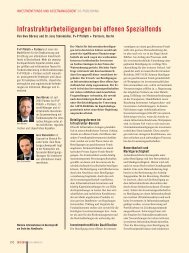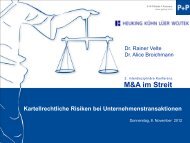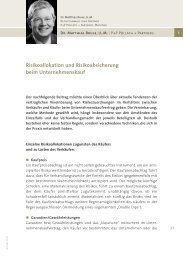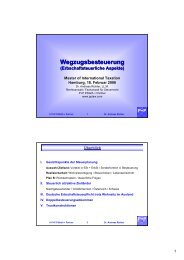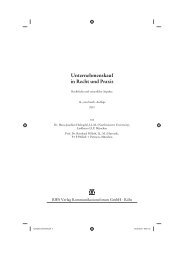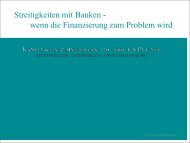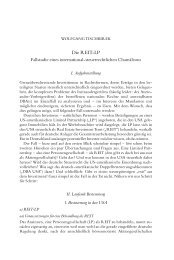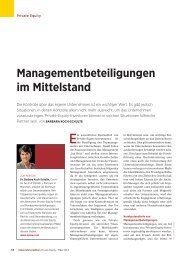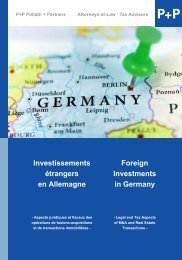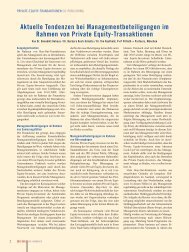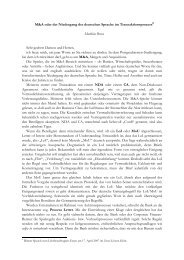The LPA AnATomised - P+P Pöllath + Partners
The LPA AnATomised - P+P Pöllath + Partners
The LPA AnATomised - P+P Pöllath + Partners
You also want an ePaper? Increase the reach of your titles
YUMPU automatically turns print PDFs into web optimized ePapers that Google loves.
This chapter was first published in <strong>The</strong> <strong>LPA</strong> Anatomised by PEI<strong>The</strong> I<strong>LPA</strong> influenceBy Tarek Mardini and Amos Veith, <strong>P+P</strong> Pöllath + <strong>Partners</strong>Introduction <strong>The</strong> Institutional Limited <strong>Partners</strong> Association (I<strong>LPA</strong>) Principles first appeared in 2009when the global financial crisis was taking its toll on all financial markets (both publicand private, equity and debt). After a moment of virtual standstill following the LehmanBrothers’ bankruptcy and AIG bailout, market participants began to assess not onlythe damage caused, but to reassess the opportunities and risks of making any newinvestments as well as the existing rules governing such investments.Contrary to certain doomsday predictions, the private equity limited partnership structure(the established governing model of private equity funds in the US, UK, Germany andmany other jurisdictions), unlike some other asset classes (asset-backed securities, forexample) proved to be robust and generally the industry emerged from the crisis withlimited damage. Nevertheless, there remained a deep sentiment in the limited partners(LP) community that some of the fund terms of the pre-financial crisis years significantlyfavoured general partners (GP) as a result of a GP-friendly fundraising environment,and, therefore, had to be scaled back to fulfil the industry’s objective that funds shouldbe long-term partnerships aligning the interests of both fund managers and investorsto deliver superior returns. <strong>The</strong> power pendulum in the negotiation of fund terms hadbegun to swing from GPs to investors in the post-financial crisis world.Particular areas of examination included whether existing fee structures were providingthe right incentives and alignment of interests between GPs and LPs, whether commoninvestor protection rules were able to deal sufficiently with market downturns and crisisscenarios, and whether the level of transparency provided in the past would be sufficientto make LPs comfortable with investing in private equity funds in a post-crisis world.<strong>The</strong> arrival of the I<strong>LPA</strong> Principles was not coincidental to this. Rather they were a directconsequence of changing LP attitudes towards certain fund terms. This chapter assessesthe impact of the Principles on the negotiation of fund terms among fund managers andinvestors and the part they have played in influencing and shaping limited partnershipagreements (<strong>LPA</strong>). It summarises the reassessment of the GP/LP relationship followingthe global financial crisis, the appearance and evolution of the Principles from version1.0 to version 2.0 (analysing the latter in more detail) and offers an outlook on industrydevelopments and regulatory factors that are likely to shape the negotiation of fundterms in the coming years.3
<strong>The</strong> <strong>LPA</strong> AnatomisedEvolution of theI<strong>LPA</strong> PrinciplesIt did not come as a surprise that LPs were looking for ways to exchange their ideason improving fund terms for the investor community. Before the I<strong>LPA</strong> Principles werepublished, investor cooperation was largely informal and not coordinated. Negotiationsof fund terms with GPs were mainly conducted on a one-to-one basis by cornerstone andlarger investors, such as pension funds. Smaller investors, on the other hand, often onlynegotiated the investor issues specific to their needs (such as special regulatory or taxrequirements, affiliate transfer or special reporting needs), which were usually addressedin a side letter to the fund agreement. Generally, they were content to receive an allocationto a fund with a good track record and, effectively, left the ‘heavy lifting’ of securingacceptable fund terms in negotiations with GPs to the larger investors.<strong>The</strong> financial crisis and the emergence of the I<strong>LPA</strong> Principles changed this relationshipdynamic. Investors, both large and small, realised the need to strengthen the alignmentof interests between fund managers and investors, to gain more control over theirinvestments and to demand better downside protection. Investor cooperation – whetherin new fundraisings or in selected cases of investor activism in existing (troubled) funds,leading to re-negotiation of terms (such as capping fund sizes or reducing managementfees) – became the new imperative. I<strong>LPA</strong>, which had already existed for some years,provided the long sought-after platform to achieve this.What is I<strong>LPA</strong>?I<strong>LPA</strong> is an international non-profit organisation based in Toronto, Canada. It was founded byinstitutional investors in the private equity asset class in the early 1990s to provide a forumfor investors to exchange information, build networks and relationships among the investorcommunity and to educate investors about the private equity asset class.Its member base currently consists of more than 250 institutional investors that collectivelymanage more than $1 trillion of private equity assets. 1 Around three-quarters of itsmembers are based in North America (US and Canada), but it also has members from allcontinents and all major investor regions around the world. Its membership is also diverserepresenting all major investor groups in the private equity asset class (including corporateand public pension funds, insurance companies, foundations and endowments, familyoffices and sovereign wealth funds). Funds of funds, however, are not I<strong>LPA</strong> members due totheir dual role of being both GPs and LPs.I<strong>LPA</strong> Principles 1.0In September 2009, I<strong>LPA</strong> published the first version of its Private Equity Principles – I<strong>LPA</strong>Principles 1.0, the culmination of ongoing discussions and consultations among investors.Although industry standardisation projects had occurred before (an example is theEuropean Venture Capital Association’s (EVCA) valuation and reporting standards), theyhad largely been driven by GPs rather than investors. I<strong>LPA</strong> 1.0 was, therefore, the first majorcoordinated attempt by investors to set out guidelines for the structuring, and terms, ofprivate equity funds and to propose best practices from an investor perspective.1. http://ilpa.org/about/4
<strong>The</strong> principles focused on three key areas:• z strengthening alignment of interest;• z enhancing fund governance and investor protection, and• z improving transparency and investor reporting.<strong>The</strong> Principles were intended not only to educate the LP community about bestpractices from an investor perspective, but also critically to facilitate discussionsbetween GPs and LPs about good fund governance and investment value creationthrough alignment of interests. <strong>The</strong>y generated a strong reaction from the privateequity community.<strong>The</strong> industry had already seen a weakening of the negotiation position of GPsdue to the reduced flow of institutional money into new funds in the aftermathof the financial crisis. While investors welcomed the Principles and immediatelybegan to use them when negotiating fund agreements, GPs – although generally inagreement with the three core principles – saw in many of the detailed proposals aclear departure from established market standards. Overall, they regarded the I<strong>LPA</strong>Principles as an ‘investors’ wish list’.In particular, GPs considered the following I<strong>LPA</strong> proposals to be departures from themarket norm:• z Clear preference for a whole-of-fund carry model over the US style deal-by-dealcarry structures.• z Significant carry escrow requirements (in particular in the case of US style deal-bydealcarry structures).• z Requirement that management fees would merely cover a fund manager’sreasonable operating costs and expenses.• z Cash funding of a GP’s commitment rather than funding through a tax-efficientwaiver of the management fee.• z In cases of a ‘for-cause’ removal of a GP, changing the review process from a finaland non-appealable court decision to a preliminary determination and, in general,reducing the suggested thresholds for simple or special investor consents in casesof no-fault divorce, no-fault dissolution and no-fault termination.Investors, in contrast, considered many of the standard market terms establishedin the pre-financial crisis years to be too GP friendly and believed they had to berecalibrated to create a better alignment of interests between GPs and LPs.5
Carried interest waterfalland clawbacksThis is one of the few remaining areas where there are significant differences between USfunds on the one hand, and European and Asian fund agreements on the other (see also‘<strong>LPA</strong>s: A regional comparison’).In European and Asian fund agreements, so-called whole-of-fund carry waterfalls areused. Here, the carry is only paid out if investors have first received a full return of theircontributed capital (including unrealised investments, management fees and expenses)plus a preferred return (often called a hurdle rate, which is typically between 6 and 8percent per year). As a result, carry payments are deferred often until the end of thefund’s investment period and thereafter. I<strong>LPA</strong> has a clear preference for such carryarrangements to reduce the likelihood that any carry paid out has to be returned due toexcess profits being distributed as carry or insufficient profits being distributed to LPs (aso-called carry clawback).I<strong>LPA</strong> Principles 2.0 acknowledge, to a greater extent than their predecessor, that adifferent carry model – the deal-by-deal carry scheme – is historically used in most USfunds. With this model, the GP already receives carry after a return of costs of realisedinvestments and write-downs and write-offs to date, plus expenses and fees attributableto realised investments. This waterfall is GP friendly and can accelerate carry payments bymany years compared to the European model. If early deals are profitable and later dealsare not, any excess carry received by fund managers would have to be returned to theinvestors.I<strong>LPA</strong> proposes that the risk of overpayment be dealt with by imposing the followingconditions on carry payouts:• z Inclusion of all (not only pro rata) deal-related costs, fees, taxes and write-offs.• z A robust escrow mechanism of at least 30 percent of carry distributions, prudentvaluations and a 125 percent net asset value (NAV) coverage test.• z Interim clawbacks tested at intervals (rather than at the term’s end) and on specificevents, such as key-person events or insufficient NAV coverage.• z Joint and several guarantees by the GP and the individual members of themanagement team and/or associates (although Principles 2.0 are more flexible thanPrinciples 1.0 and provide alternatives, if only several liability is provided, such as acreditworthy guaranty of a substantial parent company).• z Certification of carry calculations by the fund’s independent auditors.In terms of timing, I<strong>LPA</strong> requires that carry clawbacks should be repaid fully and in atimely manner (rather than within two years as proposed by Principles 1.0) and thatclawback obligations should extend beyond the fund’s term (mirroring any limitedpartner distribution giveback obligations).7
<strong>The</strong> <strong>LPA</strong> AnatomisedPrinciples 1.0 proposed that management clawbacks should be returned gross of tax. <strong>The</strong>revised Principles 2.0 softened this position and conceded that clawbacks should be net of tax.This effectively requires investors to absorb the tax burden.This is one example where I<strong>LPA</strong> reversed its position based on extensive feedback fromfund managers. However, I<strong>LPA</strong> recommends reducing the resulting tax burden by applyingindividual tax rates to each manager rather than applying the highest marginal tax rate asa hypothetical tax rate (as often used in fund agreements in the past), as well as taking intoaccount loss carry-forwards and carry-backs, and any tax changes between the formation of thefund and clawback date. I<strong>LPA</strong> considers this issue to be so important that Principles 2.0 containa newly added Appendix B dedicated to carry clawbacks.I<strong>LPA</strong> mentions that any carried interest generated by the fund manager should be directed‘predominantly’ to the professionals active in achieving the success of the fund, but stopsshort of offering detailed guidance on this point. In practice, other constituent parties mayparticipate in the carry, such as inactive founding partners, parent companies or passiveminority shareholders of a management company, whether private or publicly listed.<strong>The</strong> allocation of carry is of increasing importance for many reasons, including the successionissues faced by many funds, and the increasing number of publicly listed managementcompanies of private equity funds as well as pension funds or sovereign wealth fundsacquiring minority positions in management companies. Further guidance can be expectedin future I<strong>LPA</strong> publications.In the field of carry structures and clawbacks, the I<strong>LPA</strong> principles left their mark on thenegotiation of <strong>LPA</strong>s. Deal-by-deal carry structures are now on the decline, or at least underpressure worldwide. Even in the US, whole-of-fund structures are now slightly more commonthan deal-by-deal structures in new funds raised. 2 Investors are also now focusing on escrowsand carry clawbacks, and are demanding creditworthy guarantees. While they may not oftenget pure I<strong>LPA</strong> terms and negotiations may focus on technical details, the pendulum has clearlyshifted in favour of LPs.Management feesand fee offsetsAs management fees are not performance-related, an excessive level would create amisalignment of interests between a fund manager and its LPs. For this reason, I<strong>LPA</strong> demandsthat the level of management fees should be limited to covering reasonable salaries, operatingcosts and overhead expenses (such as rents, travel and deal sourcing) actually incurred by afund manager, rather than providing material upside compensation to managers.A reduction of management fees (known as a step down) is typically recommended by I<strong>LPA</strong> (i)at the end of the investment period (as generally seen in practice), (ii) in case of the formation ofa successor fund (though I<strong>LPA</strong> is silent on whether a step-down is recommended if only a ‘dryclosing’ of a successor fund occurred) and (iii) in the event of the extension of the fund’s term (anew requirement not previously covered).2. <strong>The</strong> 2012 Preqin Private Equity Fund Terms Advisor, p. 45-46 (regarding fundraisings and funds closed in vintage year2011/12 in North American funds: 48 percent whole-of-fund structures versus 46 percent deal-by-deal structures).8
<strong>The</strong> vast majority of funds provide for a step down of the management fee. I<strong>LPA</strong>,therefore, only describes a common practice, but the mechanics of fee reductions oftenvary substantially. Some funds only switch the base from committed capital to investedcapital, while others may also reduce the percentage fee rate. Management fees havecome down over the last few years, typically within the range of 1.5 percent to 2.5percent, and often 2 percent or lower, 3 but this continues to be an area of negotiation.Common investor sentiment is that fees are still too high and create a misalignmentbetween managers and investors. Attempting to set management fees at a level equalto actual costs would require a level of transparency, in terms of detailed information,that most managers are not willing to provide (though it is quite common that investorsask for budgetary information as part of their due diligence).<strong>The</strong> fund manager may also receive additional fees (such as transaction, director,monitoring, advisory and break-up fees) from portfolio companies or third parties.I<strong>LPA</strong> recommends that such fees should be credited in full against the managementfee for the benefit of the fund. While there was either no, or only, a 50 percent feeoffset in pre-financial crisis years, fee offsets increased over time to 80 percent andnowadays a 100 percent fee offset is often seen, though sometimes using differentoffset percentages depending on the type of fee (see chapter ‘Aligning GP and LPinterests in the <strong>LPA</strong>: New cycle, new challenges). This is the area of fund economicswhere investors have probably made the greatest progress in negotiations in the lastfew years.<strong>The</strong> I<strong>LPA</strong> Principles stress that any fees generated by an affiliate of the fund manager(for example, an advisory firm or in-house consultancy), whether borne by the fund or aportfolio company, should be reviewed and approved by the majority of the <strong>LPA</strong>C.Placement agent fees according to I<strong>LPA</strong> should be borne by the GP and not the fund.<strong>The</strong> Principles 1.0 had recommended that insurance expenses should also be borne bythe GP, but Principles 2.0 are silent on this point.General partnercommitmentI<strong>LPA</strong> emphasises that fund managers should have ‘skin in the game’. This means thatthey should make a substantial equity commitment to the fund in the form of cash,as opposed to contributions by way of a management fee waiver. Managers oftenconsider such waivers a preferable route due to tax advantages and it can be hard topersuade them otherwise (though this practice was recently further questioned by aninvestigation into fee waivers by the New York attorney general. 4In recent years, GP commitments have increased from the traditional 1 percent of totalfund commitments to between 2 percent and 5 percent, sometimes higher. Although thistrend started before the I<strong>LPA</strong> Principles were issued, it is nevertheless supported by them.3. <strong>The</strong> 2012 Preqin Private Equity Fund Terms Advisor, p.30-40 (regarding a detailed breakdown of the typical range ofmanagement fees for the various sub-categories of private equity funds).4. New York Times. ‘Financial Firms Face Subpoenas On Tax Strategy’. September 2, 2012.9
of investors positively reinstates the investment period within 180 days. This is contraryto some more manager-friendly fund agreements that provide for an automatic reenactmentof the investment period after a certain time period, unless the investors voteto make the suspension permanent.Key-person clauses continue to be heavily negotiated in practice with an emphasison time and attention requirements (including carve-outs for related predecessor andsuccessor funds) as well as on the identity of key persons (and in general more complex/tiered key person clauses).Fault and no-faultremediesIn addition to key-person provisions, cause (fault) and, in particular, no-fault remediesare the main investor protection rights (see chapter ‘Investor protection provisions’). Incase of managerial misconduct (cause event), investors should be able to remove the GP,terminate/suspend the investment period or end the term of the fund through a vote of asimple majority of investors’ commitments.I<strong>LPA</strong> does not define ‘cause’, although in practice the devil is in the detail when definingcause events. In addition, many <strong>LPA</strong> negotiations focus on whether any court determinationof a cause event must be final and non-appealable (which GPs prefer) or whether an earlycourt determination is sufficient (which LPs prefer). I<strong>LPA</strong> is silent on this point.In any event, it would usually take too long to enforce fault remedies in courts. Investorrights for cause/fault are, therefore, universally regarded as practically inefficient.However, they may be used by investors in disputes with managers as a threat to a GP’sreputation or in cases where the <strong>LPA</strong> does not provide for no-fault remedies (or only withextremely high super-majority requirements).Due to the practical inefficiencies of fault remedies, the most effective tool that LPspossess are no-fault remedies. I<strong>LPA</strong> recommends that the <strong>LPA</strong> should provide forinvestors’ rights that are exercisable through an investors’ resolution with a supermajority, even in situations without managerial misconduct (no-fault). Unlike in cases ofcause/fault, an additional court determination is not required. This makes these remediesvery attractive to investors.I<strong>LPA</strong> recommends that with a qualified majority of two-thirds (Principles 1.0recommended 50 percent), investors should be allowed to suspend or terminate theinvestment period at their discretion on a non-fault basis (no-fault termination). With aqualified majority of three-quarters (Principles 1.0 recommended two-thirds) investorsshould be able to remove the GP (no-fault divorce) or end the fund’s term prematurely(no-fault dissolution) – (see also ‘<strong>LPA</strong>s: A regional comparison’).Principles 2.0 increased the super-majority thresholds from the prior I<strong>LPA</strong>recommendations because the general market perception was that the earlier proposalsdid not reflect the market standard. In addition, managers rightly argued that onceinvestors signed up for a fund, they should not be able to change their minds (for11
<strong>The</strong> <strong>LPA</strong> Anatomisedexample, due to changing market conditions) and walk away with a simple majorityvote at the cost of other investors (and the managers). Over the years, super-majoritythresholds have been reduced in many <strong>LPA</strong>s (although not always to I<strong>LPA</strong> levels as, forexample, 80 percent is often seen for no-fault manager removal) due to I<strong>LPA</strong>’s effortsand investors’ increased awareness of the need to include such investor protectionrights.I<strong>LPA</strong> is silent on whether <strong>LPA</strong>s should contain all no-fault remedies, which would be theinvestors’ preference. Fund managers generally concede that having at least one nofaultremedy included in the <strong>LPA</strong> is market standard, but many managers are reluctantto include them all. Usually, this point is subject to intense negotiations. Investors tryto persuade managers to include many, if not all, no-fault remedies by pointing outthat having a choice between remedies can be advantageous to both investors andmanagers.In many practical instances, investors would prefer to use a less intrusive remedy (forexample, a suspension of the investment period rather than terminating the fund)to address a perceived problem. However, conceptually this would require offeringinvestors a choice of appropriate remedies. If the <strong>LPA</strong> only provides for one remedy(such as no-fault divorce), then triggering that remedy could be overkill in someinstances. Managers are, therefore, usually well advised to consider including a choiceof remedies in the <strong>LPA</strong>.Investment strategyI<strong>LPA</strong> emphasises the importance of a fund’s investment strategy to an investor’sdecision to commit to the fund. Investors allocate their resources according to specificstrategies and track records of management teams. Any changes to the investmentstrategy (the so-called style or strategy drift) should, therefore, be avoided. Thisrequires a fund to lay out a clear and well defined strategy in the <strong>LPA</strong> with meaningfullimitations on investments (including the use of debt instruments, publicly tradedsecurities and pooled investment vehicles) and diversification restrictions such asindustry concentrations.I<strong>LPA</strong> encourages funds to consider investment timing restrictions (‘pace limitations’) asit stresses the importance of time diversification during the investment period.While I<strong>LPA</strong> is generally open to allowing fund managers to accommodate investors’exclusion policies (for example, regarding certain industry sectors and/or jurisdictions),it highlights that fund managers must consider that such exclusions may have negativeconcentration effects on the remaining investors. I<strong>LPA</strong> recommends transparency ofprocess and policies of a fund manager regarding excused investment requests frominvestors.Fiduciary duty andconflict of interestsOne of the main concerns of I<strong>LPA</strong> regarding fund governance is that GPs have reducedor eliminated their fiduciary duties to the LPs, effectively replacing their obligation toact in the best interest of the fund by acting in the manager’s interest.12
I<strong>LPA</strong>’s guidance is that such practices, while possible under certain jurisdictionssuch as Delaware law, should not be permitted. <strong>The</strong> duty of care requires GPs to acton behalf of the partnership as a prudent person would act on its behalf. <strong>The</strong> dutyof loyalty requires acting in the best interest of the partnership where a conflict ofinterests is present. In other jurisdictions, this is not possible.Consequently, I<strong>LPA</strong> requires that all conflict of interests (such as cross-overinvestments and related-party transactions) should be presented to the <strong>LPA</strong>C forreview and approval rather than ‘self-clearing’ of conflicts by managers.Role of <strong>LPA</strong>CIn addition to open communications between the GP and its LPs, I<strong>LPA</strong> emphasisesthe increased role of the <strong>LPA</strong>C in fund governance, listing specifics in a separateAppendix A (see also the chapter ‘<strong>The</strong> Advisory Committee’).<strong>The</strong> Principles provide for a detailed list of responsibilities of the <strong>LPA</strong>C, includingreview and approval of conflict of interests as well as setting out a methodology ofportfolio company valuations and valuations themselves, other pre-defined consentrequirements in the <strong>LPA</strong> (such as deviations from investment restrictions) andengaging with the GP in discussions relating to fund operations (such as auditors,compliance, allocation of partnership expenses, team developments and newbusiness initiatives).Some of these suggested <strong>LPA</strong>C responsibilities go beyond what can typically be seenin <strong>LPA</strong>s, but the trend is to provide the <strong>LPA</strong>C with greater responsibilities and GPsusually appreciate its role as a sounding board.Changes to the fundI<strong>LPA</strong> has refined its stance on <strong>LPA</strong> amendments. As a general rule, it now only requiresa simple majority-in-interest of the investors (in addition to the consent of the GP)to amend the <strong>LPA</strong>. This provides managers with more flexibility to adapt the <strong>LPA</strong>to changing circumstances than Principles 1.0 when requiring a super majority forapproval.I<strong>LPA</strong> now limits super-majority approval to certain amendments without specifyingthem, though this would typically include provisions that:• z were specifically negotiated or investor-specific, such as tax or regulatory clauses;• z relate to the investment strategy (as proposed in Principles 1.0), and• z concern economics or limited liability.If an amendment would negatively affect/discriminate certain investors, it is commonto require the unanimous consent of these affected investors. I<strong>LPA</strong> suggests thatchanges to key- person clauses should be approved by a simple majority of theinvestors or the <strong>LPA</strong>C (whereas the Principles 1.0 had suggested a two-thirds vote).13
<strong>The</strong> <strong>LPA</strong> AnatomisedOther governance issuesTransparencyFinancial disclosure/additionalstandardisationtemplatesOther governance issues, which are not discussed in detail here, relate to I<strong>LPA</strong>recommendations regarding independent auditors, the engagement of independentlegal counsel by the <strong>LPA</strong>C at the fund’s expense, limitations regarding all partnergivebacks to indemnify the fund manager and extension of the fund’s term.Transparency, which is the third key area of the I<strong>LPA</strong> principles, is important as it is thefoundation on which the other two principles relating to strengthening alignment andgovernance operate.I<strong>LPA</strong> requires that managers should, periodically and individually, disclose and classify allfees in each audited financial report, and in each capital call and distribution notice.In addition to further financial disclosure rules in the Principles and Appendix C onfinancial reporting (which extends some of the proposed reporting deadlines forannual and quarterly reports suggested in Principles 1.0), I<strong>LPA</strong> has developed a set ofstandardised reporting templates based on consultations with GPs and LPs.In January 2011, I<strong>LPA</strong> published, together with the I<strong>LPA</strong> Principles 2.0, the first set ofthese templates: the ‘Capital Call and Distribution Notice Template’. This was followed bya ‘Quarterly Reporting Standards’ template in October 2011. It is intended that I<strong>LPA</strong> willprovide additional standardised reporting templates in the future.<strong>The</strong> purpose of these templates is to establish industry standards which improvetransparency, accountability and fosters greater uniformity in reporting. I<strong>LPA</strong> hopes thatthis will:• z generate industry efficiencies;• z spare the GPs time and money in processing and reporting information;• z reduce individual LP requests for additional information;• z reduce monitoring costs for LPs;• z improve communication among all partners, and• z minimise inefficiencies resulting from varying reporting standards.As is the case with the overall I<strong>LPA</strong> Principles, I<strong>LPA</strong> does not suggest that GPs adhereto every aspect of these standardised reporting templates. I<strong>LPA</strong> also recognises thata one-size-fits-all approach cannot do justice to a very diverse GP base from differentjurisdictions adhering, for instance, to different accounting standards (US/UK GAAP, IFRS).Rather, these templates serve as an indication of best practices and identify the type ofinformation and the degree of disclosure reasonably required by investors as guidanceto all market participants.14
Initial reactions from GPs have been mixed with objections such as:• z <strong>The</strong> templates are not limited to information requirements but also require certainreporting formats that deviate from the GP’s current practice.• z Some of the information required is too detailed compared to existing reportingstandards such as the European Private Equity and Venture Capital Association (EVCA)Reporting Guidelines or the International Private Equity and Venture Capital (IPEV)Reporting Guidelines.• z Templates create an undue administrative burden on GPs.Other GPs have recognised the positive effect that the templates reduce the amount ofindividual requests from LPs and the increasing efficiencies this brings.It is currently too early to give a fuller assessment on the standardised reportingtemplates as many GPs will only fully implement them in the reports covering the end of2012. In any event, I<strong>LPA</strong> has indicated that it is open to revising the templates based onfuture feedback received.Disclosures<strong>The</strong> Principles also require immediate disclosure to investors of sensitive informationrelating to the GP (for example, any changes in actual or beneficial ownership,voting control of the GP, formation of publicly listed vehicles, sale of ownership of themanagement company, public offerings of shares in the management, or formation ofother investment vehicles) and the fund’s operations (for example, any inquiries by legalor regulatory bodies, any material contingency or liability arising during the fund’s term,and any breach of the <strong>LPA</strong> or other fund documents).Some of these items go beyond what was initially suggested by I<strong>LPA</strong>, but I<strong>LPA</strong> alsodropped requests to disclose the profit-sharing split among a GP’s principals (includingvesting schedules) or individual commitment amounts of each principal as part of themanager’s commitment. That said, these points remain a very common request frominvestors as part of their commercial due diligence.I<strong>LPA</strong> added new risk management disclosure requirements to be included in the annualreports, which should cover certain risks at the fund and/or portfolio-company level (forexample, concentration, foreign exchange, leverage, realisation, strategy, reputation,environmental, social and corporate governance as well as material events). In practice,GPs have traditionally been sceptical about detailed portfolio-company level information.Risk management and risk disclosure is a major area covered by AIFMD and the industrywill have to make certain changes to current practice to adapt to such a new framework.Additional disclosure requirements are set up for contact information of investors andclosing documents. I<strong>LPA</strong> underlines that enhanced disclosure of sensitive informationgoes hand in hand with a corresponding need for confidential treatment by investors.15
<strong>The</strong> <strong>LPA</strong> AnatomisedAssessment andfuture outlook<strong>The</strong> days when European fund managers, initially confronted with the I<strong>LPA</strong> Principles,responded by saying “it’s an ‘American thing’, we have nothing to do with that” are longover. <strong>The</strong> I<strong>LPA</strong> Principles have certainly altered the relationship dynamic between GPs andLPs worldwide, though in an evolutionary rather than revolutionary manner. <strong>The</strong>y provide animportant resource and basis for discussions.Partly driven by the financial crisis, partly a natural evolution of a maturing asset class, thenew negotiation environment reflects a rather fundamental shift in the approach of investorstowards investments in private equity funds. Investors now focus more on alignment of interestsand risk management. An increased professionalism on the investors’ side is supported bygreater market transparency through database providers and specialised advisers (placementagents, financial advisers and lawyers). For that reason, although temporary swings in thebalance of power will occur in the future as markets improve, such shifts are unlikely to roll backfund terms to the manager-friendly pre-crisis levels.While the industry is far away from having one uniform fund agreement as a market standard,the room for negotiation has certainly tightened. Differences in US and European funds (andAsia and other emerging markets) will continue to shrink as can be seen with respect to carrystructures. Unlike in the past, where the differences in fund terms was black and white, futurefund term variations will likely resemble many shades of grey (see chapter ‘<strong>LPA</strong>s: A regionalcomparison’).I<strong>LPA</strong> has not been the only influencing force in the past and it will not be the only influencingpower that will shape fund terms in the future. New challenges for negotiating fund agreementswill appear. For instance, changes to the regulatory framework, such as the EU AlternativeInvestment Fund Managers’ Directive (AIFMD) or the US Dodd-Frank Act, even though mainlyfocused on regulation of managers rather than funds, will influence fund structures and theirgovernance (in particular with regulatory requirements for risk management, outsourcing ofmanagement functions and compensation). Balancing the interests of managers and investorsalike in a regulated world where one-size-fits-all regulation may overrule calibrated individuallynegotiated agreements will be required.Similarly, it will remain to be seen if significant changes to the taxation of carried interest (suchas treating carry as ordinary income rather than capital gains or applying special tax rates) willoccur and how this will influence fund remuneration structures. Such tax changes are on thepolitical agenda in many main fund jurisdictions (for example, USA, Germany and France). LPswill resist (for example, in side letters) the higher taxes of fund managers being passed on toinvestors. Future I<strong>LPA</strong> publications are likely to have to deal with the negative economic impactof changes in taxation.Industry trends will also impact existing fund terms and will influence the evolution of I<strong>LPA</strong>.For example, the growth of private equity firms to larger multi-asset management institutionscomparable to investment banks could mean that the asset class will become less of a people’sbusiness and ultimately this could affect how investors think about key-person clauses. FuturePrinciples issued by I<strong>LPA</strong> might have to address this and other challenges raised by new trends, such16
as the emergence of separate managed accounts, the increasing use of corporate fund structures(as opposed to partnership structures), listed private equity funds, succession issues of private equityfirms, dealing with ‘zombie funds’ (see ‘Aligning GP and LP interests in the <strong>LPA</strong>: New cycle, newchallenges’ at page 23) or the increasing volume of secondary fund interest transactions.For the moment, and more important than ever, both GPs and LPs have to be aware of marketstandards and best practices when negotiating fund terms, whether by building up their ownknow-how or by using experienced advisers.Each investor has its own experience and position regarding compliance with the I<strong>LPA</strong>Principles. However, it is true that only a minority of investors would dismiss outright theopportunity of investing in a fund solely on the grounds that the GP does not adhere to most ofthe I<strong>LPA</strong> Principles. Yet, the general opinion is that a majority of investors would at least considerthis as a reason not to invest.<strong>The</strong>refore, to the extent fund managers decide to deviate from individual I<strong>LPA</strong> proposals,they should expect to proactively communicate and explain deviations to investors that areincreasingly sensitive to terms and conditions. In a tough fundraising environment, adhering tothe I<strong>LPA</strong> Principles can be a marketing tool for managers.At the end of the day, a well-balanced fund agreement is in the long-term best interests of bothGPs and their LPs. nTarek Mardini is a counsel and attorney in the Berlin office of <strong>P+P</strong> Pöllath + <strong>Partners</strong>. As a member of theprivate funds team, Tarek advises fund managers and institutional investors on legal, tax and regulatoryaspects of structuring investments in private equity, mezzanine and other alternative investment fundsworldwide. Tarek’s expertise includes advising on fund governance issues (including I<strong>LPA</strong> principles anddispute situations) as well as tailored reviews of terms and conditions of private equity funds. He hasadvised on a number of secondary fund transactions (including large portfolio sales).Amos Veith is a partner and attorney with <strong>P+P</strong> Pöllath + <strong>Partners</strong> in Berlin. He has practiced tax andcorporate law as a lawyer since 2000 and has assisted clients in structuring and reviewing more than 100private equity and similar closed-end funds. Amos studied law and philosophy in Bonn and Cologne, andhas an LLM in environmental law from the University of Aberdeen. He specialises in tax and legal advicefor domestic and foreign institutional and private investors and initiators in the field of private equity fundsand similar alternative investment vehicles, funds of funds and secondary transactions.About <strong>P+P</strong> Pöllath + <strong>Partners</strong>As a major German commercial law firm with roughly 100 lawyers, <strong>P+P</strong> has a market leading private fundspractice in Germany with one of the largest and most sophisticated private funds practices in continentalEurope. <strong>P+P</strong> is committed to provide outstanding client service and results backed by 25 dedicatedfund lawyers, who bring in-depth expertise and innovative and practical solutions to and strategies forall complex legal, regulatory and tax issues of private fund sponsors, managers and investors regardingfund structuring, investor representation, secondary transactions, carried interest and management feeplanning, regulatory affairs, retail funds, asset manager M&A, management succession issues as well asfund litigation and dispute resolution. With the support of a global network of prestigious “best friend”law firms from all major fund jurisdictions, some of whom have contributed to this book, <strong>P+P</strong> providesseamless service through its integrated team approach to clients worldwide.For more information, visit www.pplaw.com17
Published byPEISycamore HouseSycamore StreetLondon EC1Y0SGUnited Kingdom



